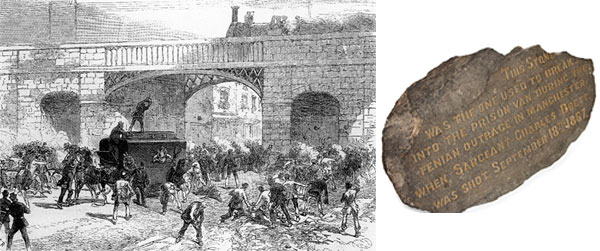The stone that ‘smashed the van’
Published in Artefacts, Issue 2 (March/April 2017), Volume 25By Lar Joye
With the failure of the invasion of Canada in 1866 and the rising of March 1867 (see HI 16.6, Nov./Dec. 2008: The Fenians—150th anniversary special), the Fenian movement moved its focus to England. Fenianism had already spread to England in the preceding years and had close associations with English working-class movements there. The Fenians in England were led from the summer of 1867 by Col. Thomas J. Kelly, originally from Mountbellew, Co. Galway, who had served in the 10th Ohio (Irish) regiment of the Union Army in the US Civil War.

Above: The ‘smashing of the van’ containing Fenian prisoners Thomas J. Kelly and Timothy Deasey under the Hyde Road railway arch in Manchester, 18 September 1867, and (right) the stone used. (Illustrated London News; NMI)
The response from the British authorities was swift and there was a wave of anti-Irish protests in England. Twenty-nine men were arrested and five were convicted of murder. Edward Condon, who was an American citizen, had his sentence commuted; Thomas Maguire was discharged, as there were doubts about the evidence against him. The British cabinet decided against a reprieve for William O’Meara Allen, Michael Larkin and William O’Brien, however, and they were publicly hanged in Salford jail on 23 November 1867. Their executions created a ground swell of support for the Fenian movement, in particular in Manchester, where 15% of the city’s population was Irish-born. It was felt that they had been hanged to placate public opinion and there was no proof that any of the three had fired the fatal shot. The song God save Ireland, based on the slogan used in the court case, became widely popular, while a number of mock funerals were held throughout Ireland—over 30,000 people attended the Dublin one. Over a number of years Manchester Martyr memorials were built in towns around Ireland; they would became focal points for commemorations for Irish nationalists and the Irish Volunteers after 1913. Neither Col. Kelly nor Capt. Timothy were ever captured; they returned to the USA and were not subsequently active in the Irish nationalist movement.
Lar Joye is curator of military history at the National Museum of Ireland.
















